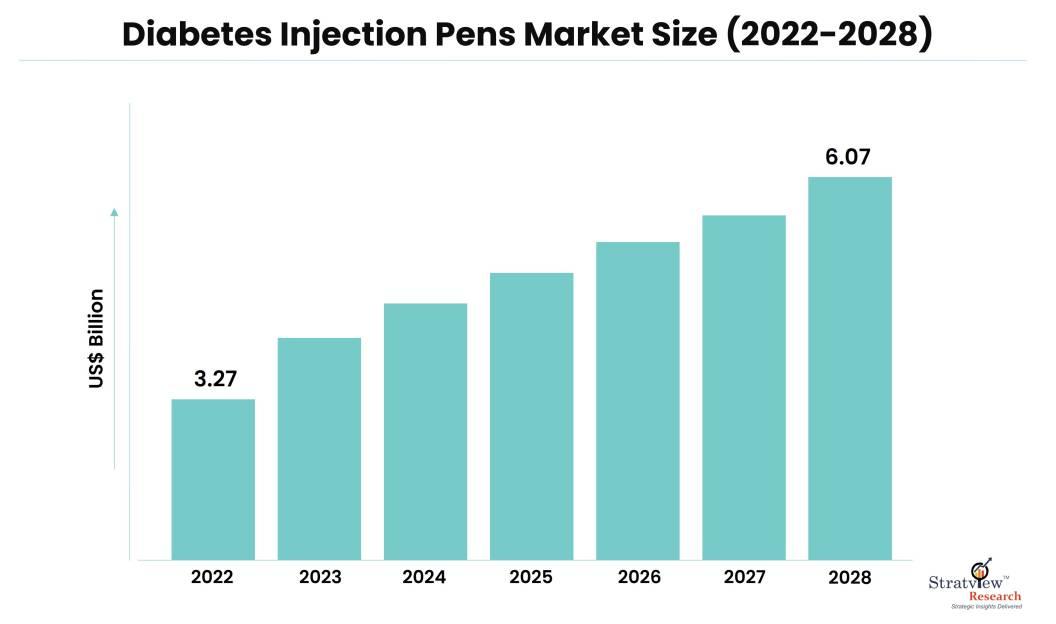The prevalence of diabetes is on the rise worldwide, with millions of people depending on insulin injections for managing their condition. As a result, the demand for diabetes injection pens has experienced significant growth in recent years. These convenient and user-friendly devices have emerged as a popular choice among individuals with diabetes and healthcare professionals alike. This article aims to explore the key drivers behind the rising demand for diabetes injection pens and the growth opportunities this trend presents. The diabetes injection pens market is estimated to grow from USD 3.27 billion in 2022 to USD 6.07 billion by 2028 at a healthy CAGR of 10.80% during the forecast period.
Ease of Use and Convenience:
One of the primary drivers behind the increased demand for diabetes injection pens is their ease of use and convenience. Unlike traditional vials and syringes, injection pens offer a more straightforward and hassle-free method of administering insulin. They are compact, portable, and often come pre-filled with insulin cartridges, eliminating the need for manual drawing and measuring of doses. The user-friendly design, intuitive controls, and clear dosage indicators make injection pens highly accessible to individuals of all ages, including older adults and children.
Improved Treatment Adherence:
Treatment adherence is crucial for successful diabetes management, and injection pens have played a significant role in improving patient compliance. The simplicity and convenience of injection pens make it easier for individuals to adhere to their insulin therapy regimen. The pens provide accurate dosing, reducing the risk of errors and ensuring consistent delivery of insulin. Some pens also offer dose memory and reminder features, helping users keep track of their injections and adhere to prescribed treatment plans more effectively.
Technological Advancements:
Technological advancements have greatly contributed to the rising demand for diabetes injection pens. Manufacturers have incorporated smart features into these devices, such as Bluetooth connectivity and mobile apps. These connected pens allow individuals to track and monitor their insulin dosage, blood glucose levels, and other relevant data in real-time. The availability of personalized insights and recommendations through mobile apps empowers users to make informed decisions about their diabetes management, enhancing treatment outcomes and overall well-being.
Needle Safety and Comfort:
Needle safety and comfort have been significant areas of improvement in diabetes injection pens, further driving their demand. Manufacturers have developed ultra-thin needles with finer gauges, reducing pain and discomfort during injections. Some pens employ needle technologies that minimize the risk of needlestick injuries and offer safety features like automatic needle retraction and shielding. These advancements in needle technology have addressed concerns and fears associated with injections, making injection pens a more attractive option for individuals with diabetes.
Market Expansion and Awareness:
The increasing prevalence of diabetes, coupled with a growing emphasis on diabetes education and awareness, has contributed to the expansion of the diabetes injection pen market. Healthcare professionals are recognizing the benefits of injection pens and actively promoting their use to their patients. Moreover, pharmaceutical companies are investing in marketing initiatives and awareness campaigns to educate individuals with diabetes about the advantages of using injection pens over traditional insulin delivery methods. This market expansion and improved awareness have led to a surge in demand for these devices.
The rising demand for diabetes injection pens presents numerous growth opportunities in the market. Manufacturers are continually investing in research and development to enhance the features and functionality of these devices. There is a growing focus on incorporating artificial intelligence and machine learning algorithms to further personalize insulin dosing and improve treatment outcomes. Additionally, there is room for innovation in terms of eco-friendly and sustainable materials, refillable pens, and advancements in connected healthcare technologies.
In conclusion, the increasing demand for diabetes injection pens is driven by their ease of use, improved treatment adherence, technological advancements, needle safety and comfort, and market expansion. The growth opportunities in this market are vast, and continued innovation in the field of diabetes management will further propel the demand for these devices. With ongoing advancements and a greater emphasis on patient-centric care, diabetes injection pens are set to play a pivotal role in improving the lives of individuals with diabetes and shaping the future of diabetes management.
